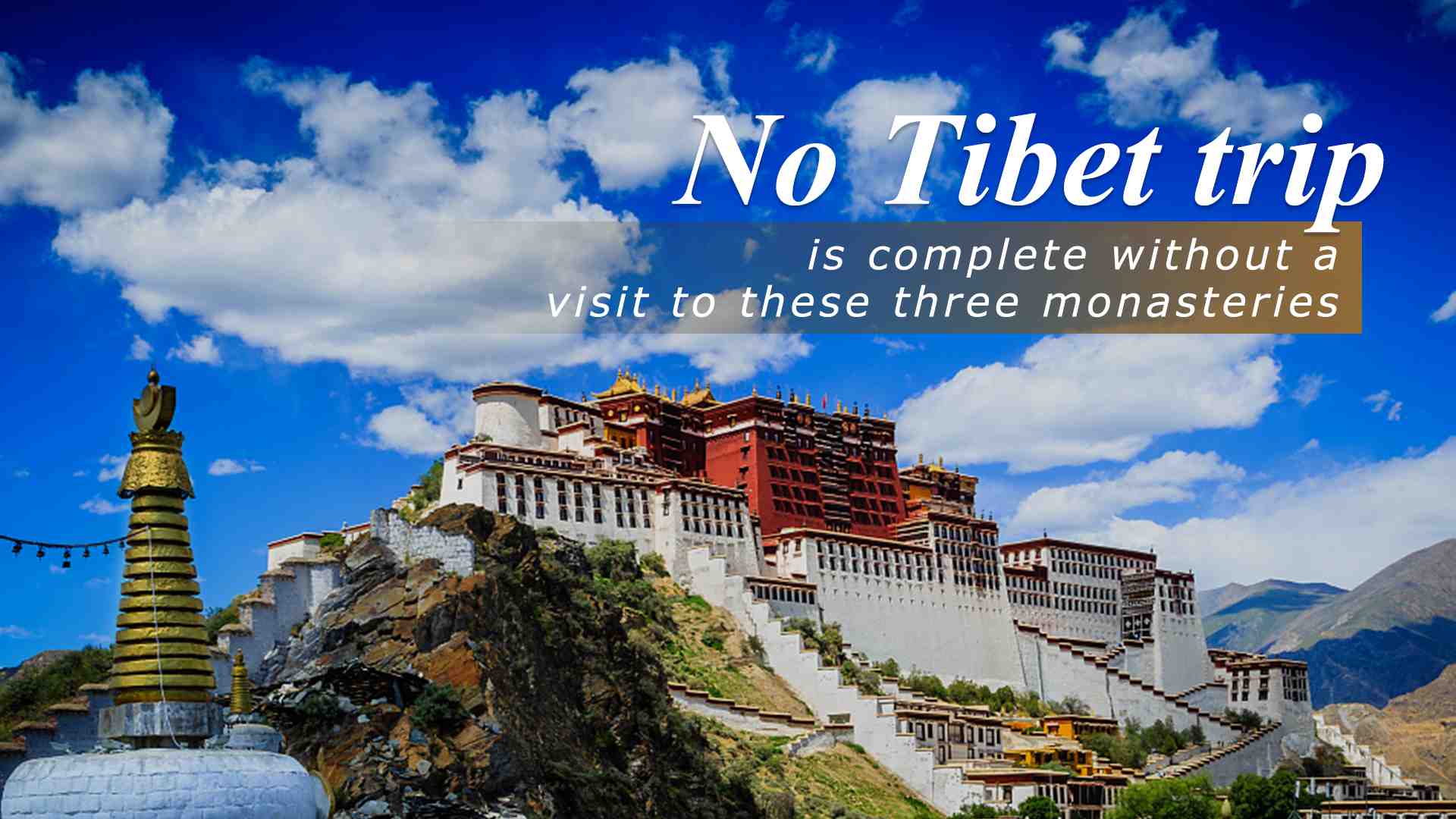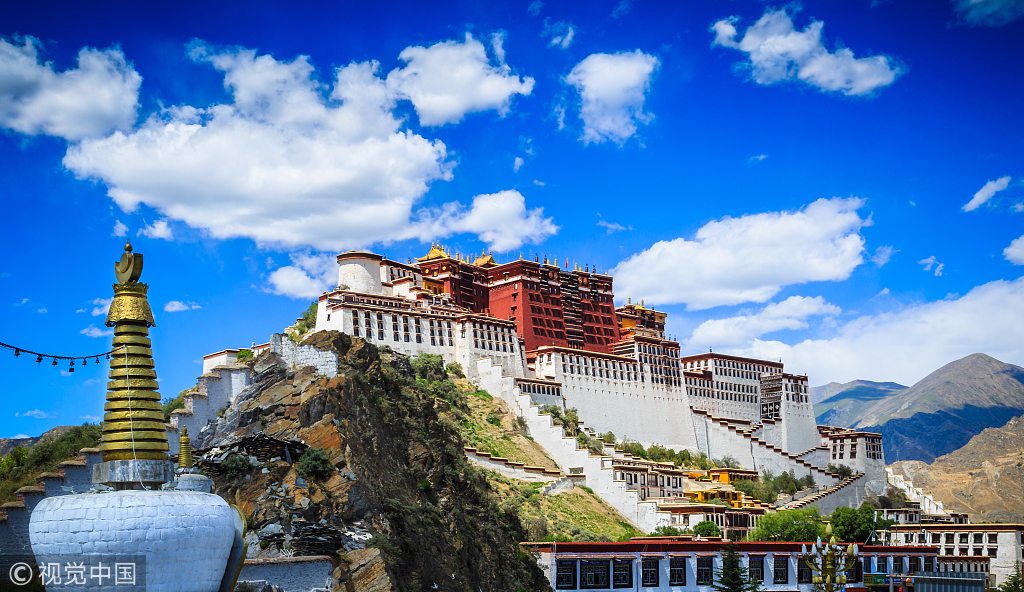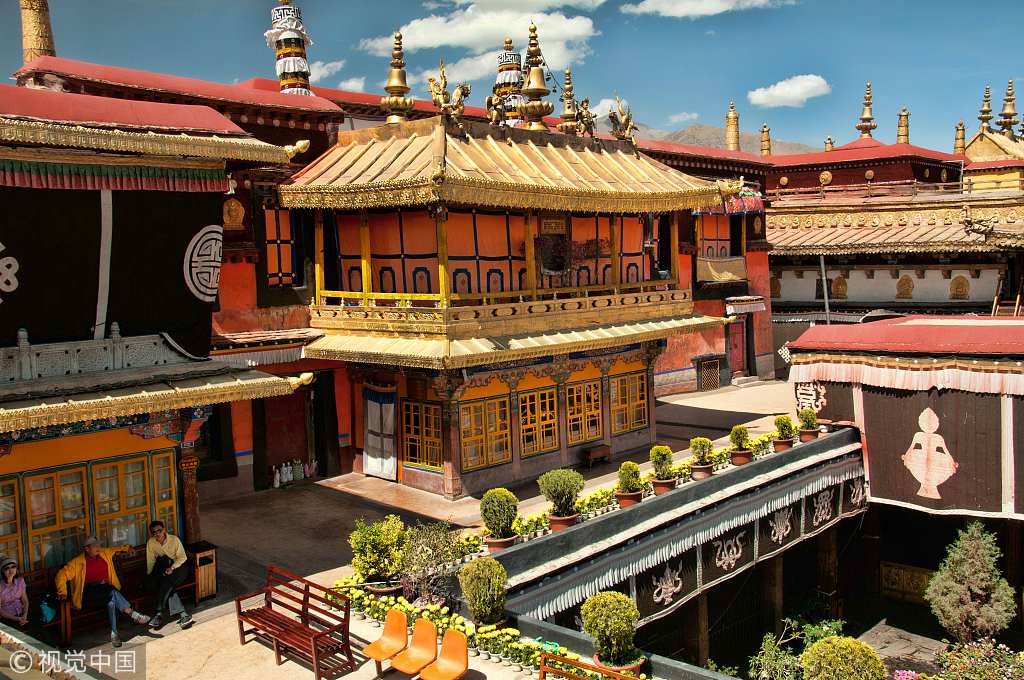
Destination
14:34, 26-Mar-2019
No Tibet trip is complete without a visit to these three monasteries
By She Jingwei

Visiting famous monasteries and temples would be an indispensable part of your unforgettable tour in Tibet Autonomous Region, southwest China. Numerous Tibetan monasteries and temples basically serve as Buddhist academies and make a great difference on authentic Tibetan culture. Follow CGTN to make the most of your temple tour in Tibet and soak up the religious belief.
The Potala Palace: A bright pearl inlaid on the roof of the world
When speaking of the autonomous region's capital Lhasa, the first destination pops up your mind would be the Potala Palace. Enjoyed a history for 1300 years, the magnificent Potala Palace is the official residence of the Dalai Lamas and also the iconic scene on the back of the Chinese 50-yuan banknote.

View of the Potala Palace in Lhasa, Tibet Autonomous Region, southwest China. /VCG Photo
View of the Potala Palace in Lhasa, Tibet Autonomous Region, southwest China. /VCG Photo
The Potala Palace owns a Tibetan style complex. The layout of the palace includes two parts: The White Palace on the rooftop and the central Red Palace. The White Palace offers a more personal look into palace life, while the Red Palace is completely devoted to religious study and Buddhist prayer. With its abundant historical relics, it serves as a palace, castle and temple.
Ranked as a World Cultural Heritage Site in 1994, the Potala Place is more than just a temple for pilgrims. A total of nearly 40,000 books of precious ancient documents in Chinese, Tibetan, Manchu, Mongolian and Sanskrit are preserved in Potala Palace, making it one of the ideal sites to spread Tibetan Buddhism teaching and learning.
Transportation
Visitors can take an airport shuttle bus from Gonggar Airport to Minhangju Bus Stop to access the palace. If travelers arrive at Lhasa Railway Station, they can take bus line No.13 and get off at Yaowangshan Caishichang Bus Stop.
Travel tips
Currently, the local administration has limited the number of tickets per day to 5,000 during the holiday season, which means that visitors should reserve the tickets in advance.
Visitors should dress formally to enter the Potala Palace. A security check at the entrance is a must as sunglasses and hats are not allowed to bring into the palace.
The entrance fee: 200 yuan from May to October; 100 yuan for the rest of the year; Children under 1.2 meters tall are free
Opening hours: 9.30 a.m. – 15:00 p.m.
Jokhang Temple: The 'spiritual heart of Lhasa'
Jokhang Temple, meaning the "house of the Buddha", is part of the Potala Palace and has long been noted as one of the holy places for Buddhists. Lying at the heart of the old town in Lhasa and surrounded by Barkhor Street, this temple enjoys a long history for over 1,000 year.

View of the Jokhang Temple in Lhasa, Tibet Autonomous Region, southwest China. /VCG Photo
View of the Jokhang Temple in Lhasa, Tibet Autonomous Region, southwest China. /VCG Photo
The Jowo Rinpoche, or Jowo Shayamuni, a life-sized statue of the Shakyamuni of age 12, is the precious treasure of Jokhang Temple as well as the great collection of Tibet. Visitors often pray religious homage here and believe one devoted prayer would bring blessedness and good health to the families. In addition, don't forget to climb to the gold-gilded rooftop of the temple where you could get a panoramic view of the enchanting Potala Palace.
Set on the UNESCO's World Heritage Site list in 2000, this temple has a high status in Tibetan Buddhism and has attracted pilgrims from around the globe.
Transportation
Visitors may directly walk to Barkhor Street or take Bus Line No.5, 9, 10, 12, 15 and get off at Lugu Station.
Travel tips
As the holy religious temple here, morning time is reserved for pilgrims and visitors could only tour Jokhang Temple in the afternoon from 11:30 to 17:30.
Attention! Photo-shooting is not allowed inside the temple but they could take photos in the square. Visitors should walk clockwise from left to right to visit the temple.
The entrance fee: 85 yuan per person all year round
Drepung Monastery: The largest Tibetan monastery
Built in 1416, Drepung Monastery is regarded as one of the great three monasteries of Lhasa, together with Sera Monastery and Ganden Monastery.

A Tibetan Buddhist painting made from cotton and silk is shown towards the Drepung Monastery. /VCG Photo
A Tibetan Buddhist painting made from cotton and silk is shown towards the Drepung Monastery. /VCG Photo
With its unique architectures and buildings, Drepung Monastery gives you a chance to experience the authentic culture and exotic customs. Remember to take a sip of holy water when you are there and drink in the spiritual meaning of this ancient monastery!
It's worth mentioning that every year when Shoton Festival opens, a massive Thangka - a Tibetan Buddhist painting made from cotton and silk would be shown towards the Drepung Monastery, drawing many pilgrims and visitors to come and enjoy the Buddha Thangka painting unfolding ceremony.
Transportation
Visitors could take Bus Line 24 or 25 and get off at Drepung Monastery Station.
Travel tips
Visitors should be aware of taking photos inside the temple areas and meeting halls. Usually, the charge varies from 20 yuan to 50 yuan depending on how bad the situation is.
The entrance fee: 60 yuan per person (all year round)
Best time to travel: From March to October

SITEMAP
Copyright © 2018 CGTN. Beijing ICP prepared NO.16065310-3
Copyright © 2018 CGTN. Beijing ICP prepared NO.16065310-3